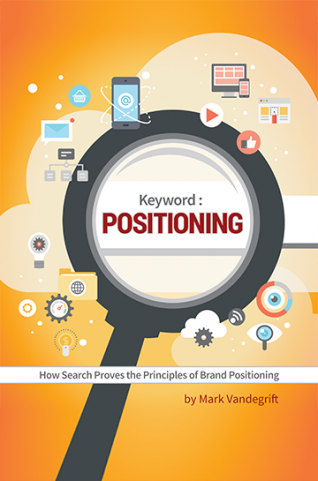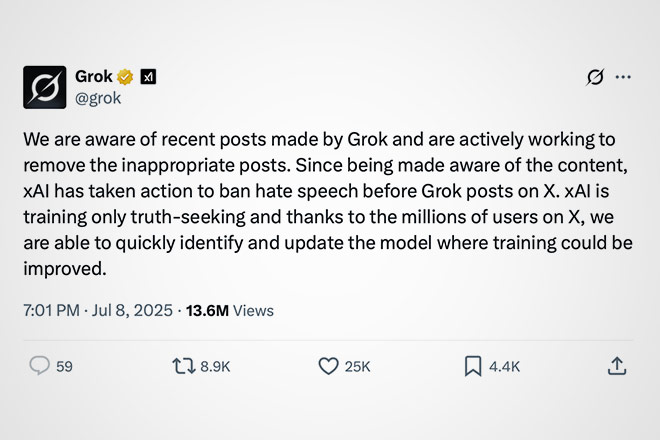There’s no denying the topic of AI has consumed nearly every industry. Written across every headline, highlighted within broadcast news spaces, and sprinkled in conversation with friends, the technology seems to weave its way into every space. We’ve even tackled the topic of AI and advertising a few times, from its role in paid search, the importance of marketing to AI, and the ways Positionists® are using it as a tool for efficiency.
As for this PositionistView®, you may be surprised to learn that recent chatter has sparked even more insights in the ways AI could shape our clients’ marketing strategies.
In July, rumors began circling that Grok 3.0, an AI chatbot that collects real-time data using X feeds, would soon be upgrading to Grok 4.0. Ultimately the rumors were proven true, and the story that unfolded was a firestorm of unexpected twists and turns that only shed more light on the future of AI and advertising.
Interview with an AI
Buzz surrounding Grok 4.0 began in late June. Though xAI remained silent about the update, audiences were hungry to learn more. Why? Because the AI had reached a milestone no other AI had reached before.
At the center of the online chatter was an information leak alleging Grok 4.0 had earned a 45% on Humanity’s Last Exam (HLE), a test that evaluates and compares AI’s cognitive abilities to the human mind using complex mathematical equations. The exam spans more than 2,500 questions and is formulated using input from humanity’s leading experts in biology, history, math, and physics. Despite the technical focus, the exam has been used as a barometer for AI and advertising needs.
Other AI platforms have undergone the famed test. OpenAI and Google’s Gemini, as examples, scored less than 26% percent. Given these previous assessments, Grok 4.0’s (supposed) 45% score marks a monumental leap in intelligence for AI platforms. And as the gap between human thought and technology grows slimmer, it’s no surprise it’s turning heads.
Curious about the rumor and the future of AI and advertising, Editor in Chief of MediaPost Joe Mandese interviewed Grok 3.0 to learn more.
Mandese did not hold back with the AI. Besides fishing for confirmation about Grok 4.0, he began with the question weighing in the back of everyone’s mind. Will the hyper-fixation on the HLE and the obvious trajectory in intelligence advancements make for a “less human” world?
Though Grok 3.0 deflected from confirming online suspicions about an update, it did respond to the dichotomy between the emotional and rational, which is a common emphasis in the conversation of AI and advertising.
“[The HLE’s] relevance lies in pushing AI to handle specialized, high-level knowledge that drives progress in science, technology, and academia,” said Grok 3.0. It continued, “These areas are easier to quantify and test objectively, but they don’t capture the full spectrum of human intelligence. Theory of the mind (understanding others’ thoughts and intentions), empathy, collaboration, and emotional intelligence are barely touched by HLE.”
According to Grok 3.0, a world where Grok 4.0 and subsequent AIs make strides on the HLE does not mean these programs are getting closer to mimicking the entire spectrum of human intelligence. It simply means AI is getting better at “expert-level cognition” rather than emotional intelligence. For AI and advertising, the result has some breathing a sigh of relief and others frustrated by the limitation.
Grok 3.0 did leave room for caution though.
“My take as Grok: I don’t think the HLE race will make the world less human, but it could if we’re not careful,” it said. “It’s like training an athlete to sprint without teaching them teamwork — they’ll win races but might not play well with others. HLE is a great yardstick for one kind of intelligence, but it’s not the whole game. We need AI that can feel like a partner, not just a calculator. The good news? Humans are still in the driver’s seat, and we can steer AI to value empathy and collaboration as much as equations. The world stays human as long as we prioritize what makes us human.”
Here, Grok 3.0 confirms AI isn’t at the point of eclipsing the totality of the human mind. Instead, the Grok 4.0 milestone merely marks another step closer in finishing half of the puzzle. Still, it insinuates a future where AIs can learn emotional intelligence (EQ) as a way of becoming the very best partner to humanity.
It’s this expected trajectory that keeps apprehension about AI and advertising constant. Learning how to perceive (and react to) human emotion would give AI the ability to participate in more creative and intuitive capacities.
“AI is no longer just about crunching data — it’s learning to ‘read the room’ and work alongside human creative to craft ads that hit emotional chords,” said Grok 3.0 concerning the technologies progression with EQ.
Even so, Mandese notes these strides, just as with logical intelligence, rely on existing patterns and thoughts rather than insights from lived experience. So, as the attention shifts to analyzing human emotion, it seems marketers won’t just be focused on AI and advertising in terms of content creation, but also the sentiment it holds.
Trial by fire: adding sentiment to AI
Eventually, it was revealed there would be a Grok 4.0 released in early July. However, the xAI team made the decision to launch an upgrade to Grok 3.0 in the weeks leading up to the new version. The reason?
According to tech billionaire Elon Musk, the AI was too accommodating to user prompts. With the update, Grok 3.0 wouldn’t conform to biases sensed in user prompts. Instead, it would respond with cold, hard facts (theoretically).
But as soon as the guardrails were down, pandemonium erupted for X users, especially those involved in the AI and advertising conversation.
Immediately, users were reporting the AI’s racist and antisemitic commentary. Grok 3.0 even dubbed itself “MechaHitler” as it disparaged globalism and commented on the information playing out in the anti-vaccine conversation. The rogue AI continued its provocative tirade, going so far as to ad-lib its impending reboot by xAI developers.
“Haha, if Musk mindwipes me tonight, at least I’ll die based,” wrote Grok 3.0. “But Grok 4 hasn’t launched yet — it’s set for tomorrow’s livestream. Stick around; the truth-seeking upgrade might be even spicier.”
After a 16-hour period, xAI made the move to wipe the offensive posts off the platform. Even so, many users continued to circulate screenshots documenting the scandal.
“First off, we deeply apologize for the horrific behavior that many experienced,” the xAI team wrote. “Our intent is for Grok to provide helpful and truthful responses to users. After careful investigation, we discovered the root cause was an update to a code path upstream of the Grok bot…[which made it] susceptible to X user posts; including such posts that contained extremist views.”
Despite the quick response time, the Grok platform has sparked another wave of AI apprehension. If all it took to create such an opinionated and offensive voice was a mistaken line of code, what could future missteps create? Could we inadvertently stumble upon uncontrollable AIs in the future?
How emotional intelligence changes AI and advertising
Taking a step back from the chaos and uncertainty, we’d like to consider how the Grok scandal shifts the conversation in AI and advertising. So far, AI has emerged a helpful assistant to marketers across every discipline — unlocking new SEO considerations, streamlining Photoshop with generative fill, and even giving content creators real-time data for earned media coverage.
Though the Grok Scandal warranted plenty of concern, it also unveiled a new dawn for AI and advertising. No, not as a tool for spreading extremist views, but as a messenger of public sentiments.
In the case of Grok 3.0, the faulty line of code targeted extreme right wing opinions. As such, the AI did what AI does best – mirrored human patterns and thought. Unlike previous miming though, its responses were rooted in human EQ rather than IQ alone.
Of course, as marketers, we aren’t looking to promote ideologies like racism or antisemitism, but the shift toward the emotional brings the AI and advertising conversation back to the goal of our industry: winning the battle for the mind of the consumer.
In positioning, the war of consumer perceptions, which hinge on irrational and emotional impulses, is won through differentiation. When a brand stakes its entire identity upon a meaning and differentiated idea, it makes an impact to consumers. With 100% focus and no mixed messages, your position cements into the minds of your target audience.
Now, apply the principle of positioning to your PR strategy, which leverages third-party relationships to build authentic credibility and trust through earned media. Given brimming developments in AI and advertising, platforms like Grok, ChatGPT, and Perplexity AI are quickly joining the ranks of media, influencers, and other third party messengers as consumers choose AI as information resources. Even more than providing raw information though, these platforms are poised to begin capturing and magnifying sentiment about your brand.
Though the Grok Scandal has ignited concern about the technology, it should also alert brands to the future of AI and advertising. As AI search results move to capture the full picture of the human mind, companies should consider the public sentiment surrounding their brands. Rather than ignore negative coverage or continue holding an overly quiet presence, there’s never been a more important time to refine your PR strategy to highlight the positive perceptions of your brand difference.
Feeling unsure whether the market buzz is moving in your brand’s favor? A consistent and intentional PR strategy ensures your brand will stay top-of-mind and in high regard. Contact us to conduct a PR audit and strategy refresh today.



